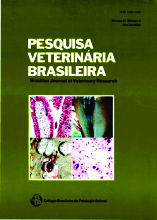 |
|
|
|
Year 2003 - Volume 23, Number 2
|

|
Clinical and hematological evaluation of Nelore calves experimentally infected with isolates of Babesia bigemina from the Southeastern, Northeastern and Northern regions of Brazil, 23(2):52-60
|
ABSTRACT.- Mendonça C.L., Vieira D., Kohayagawa A., Schenk M.A.M., Madruga C.R. & Afonso J.A.B. 2003. [Clinical and hematological evaluation of Nelore calves experimentally infected with isolates of Babesia bigemina from the Southeastern, Northeastern and Northern regions of Brazil.] Avaliação clínica e hematológica em bezerros Nelore infectados experimentalmente com isolados de Babesia bigemina das regiões Sudeste, Nordeste e Norte do Brasil. Pesquisa Veterinária Brasileira 23(2):52-60. Clínica de Bovinos, Campus Garanhuns, Univ. Fed. Rural de Pernambuco, Cx. Postal 152, Garanhuns, PE 55292-901, Brazil.
A comparative study was made regarding the clinical and hematological alterations caused by isolates of Babesia bigemina from southeastern, northeastern and northern Brazil in experimentally infected Nelore calves. Eighteen calves between 7 and 9 months of age, without antibodies against Babesia sp and raised free from ticks, were used. Three animais were previously inoculated with 2.0x109 parasitic erythrocytes (PE) for each stabilate. The other 15 calves were subdivided into three groups, with five animais each, that were subinoculated with 1.0x1010 PE of the respective isolates. The clinical and hematological alterations were evaluated by the determination of parasitaemia, haemogram, plasmatic fibrinogen,reticulocyte count, descriptive analysis of the bone marrow and erythrocytic osmotic fragility, for 30 days, totalizing seven moments of observation. The follow-up of the immunological response by the indirect fluorescent antibody test was carried out daily until the 10th day after inoculation (DAI) and after that, on the 151 20th, 25th and 30th DAI. A mild clinical manifestation of the disease was observed. The laboratory findings revealed low leveis of parasitaemia; decrease of the erythrogram values; absence of reticulocytes, initial decrease in the total count of leukocytes, neutrophils and lymphocytes with a posterior elevation of the number of these cells; hypercellularity of the erythrocytic series and decrease of the myeloid: erythroid relation which was more accentuated between the 8th and 12th DAI, and an increase of the erythrocytic osmotic fragility in the groups inoculated with the Southeast and Northeast isolates. None of the three isolates of B. bigemina gave rise to the clinical characteristic form of the disease, although they induced an humoral immune response. |
| |
|
|
| |
|
 |